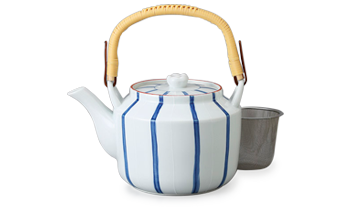How to Pick the right Japanese Tea Set
With all the teacups and teapots you can pick from these days, you may have difficulty picking a Japanese tea set that suits your tastes and preferences. Since green tea has been consumed in Japan for centuries, the sizes and shapes of teacup and teapot selections have changed throughout time. Also, specific varieties of green tea have their own characteristics, which influences your choices. Keep reading to learn more about Japanese tea set distinctions and designs.
Selecting the right Japanese Teapot
Stylistic preferences aside, we encourage you to consider the following criteria when browsing for Japanese teapots, as well as their filter types, sizes, shapes, and materials.
Porcelain Teapots vs. Clay Teapots
For the most part, the materials Japanese teapots are created either with stoneware (clay) or porcelain. When it comes to clay teapots, you’ll have greater interaction between the pot and the tea. Clay varieties – such as Banko-yaki and Tokoname-yaki – are renowned for creating tea with a mellower taste, as the umami element is enhanced. This can be attributed to the iron content in clay, which is high. A subsequent chemical reaction is produced by the tannins inside the leaves of the tea.
On the other hand, porcelain teapots are quite flexible - they can brew all kinds of teas because the aroma of the drink is absorbed by the pot.
4 Fundamental Shapes of Japanese Teapots
When it comes to Japanese teapots, there are a quartet of fundamental shapes. The key distinction between them all comes down to the design of the handle. If you’re wondering what the difference is between a “kyusu” and the Japanese teapot, the answer is: they’re both the same thing.
Side-Handle Teapot (Yokode Kyusu)

On a yokode kyushu, the handle will usually be found on the right portion. This allows you to place your thumb on the lid top, stopping it from coming off during your pour.
Sizes of Japanese Teapots
When browsing for teapots, it is vital to keep in mind which size is ideal for the tea you plan to serve. For instance, if you enjoy gyokuro and tend to drink it alone, you’ll be fine using a hohin. It may be worthwhile to get a big dobin if you enjoy drinking hojicha with your family after a meal.
It is feasible to have sencha prepared with a big dobin. Be mindful, though, that it can be troublesome to control the water temperature with this teapot. Inconsistent seeping may ensue.
Is a Yuzamashi Required?
A cooling cup without a lid is called a yuzamashi. The handle is either on the side or back, and occasionally, it features a pour spout. A yazamashi can be used to bring down the temperature of boiled water. Though it isn’t essential to use, a yazamashi can be a great addition to a green tea collection.



